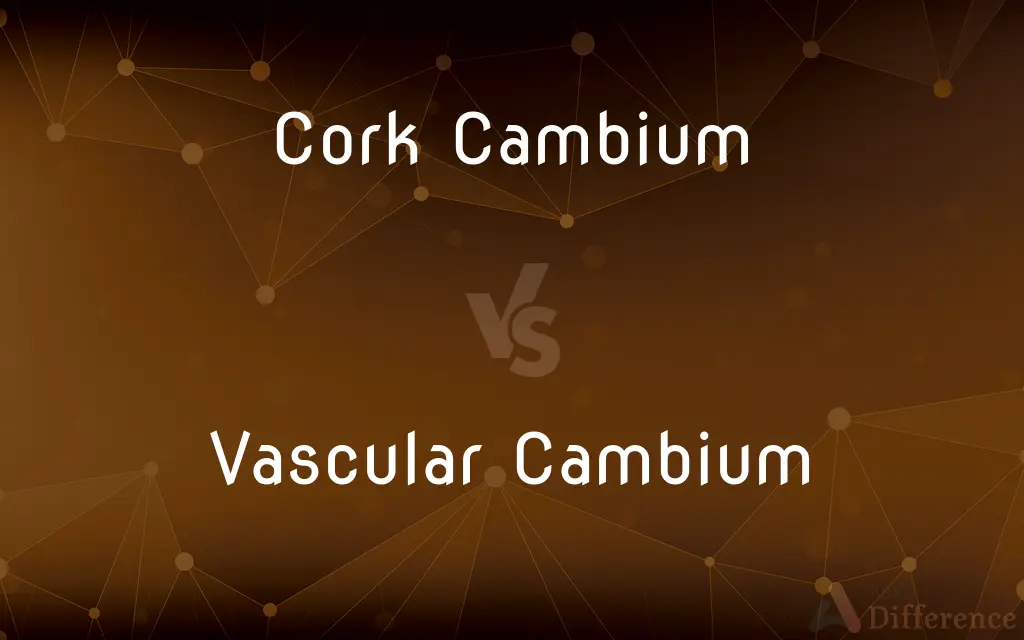Cork Cambium vs. Vascular Cambium — What's the Difference?
By Tayyaba Rehman — Published on November 19, 2023
Cork Cambium produces protective outer tissues; Vascular Cambium generates inner transport tissues in plants.

Difference Between Cork Cambium and Vascular Cambium
Table of Contents
ADVERTISEMENT
Key Differences
Cork Cambium is a type of meristematic tissue that resides in the outer regions of the plant. It has the responsibility of producing cells that eventually differentiate into cork, providing a protective barrier for the plant against physical damage and pathogens. This protective layer also prevents excessive water loss.
Vascular Cambium, on the other hand, is another form of meristematic tissue but is located between the xylem and phloem of the plant. It plays a pivotal role in secondary growth, producing cells that become part of the plant's transportation system. The Vascular Cambium helps in expanding the plant's girth by producing xylem (towards the inside) and phloem (towards the outside).
Both Cork Cambium and Vascular Cambium are integral to a plant's growth and health. While Cork Cambium focuses on fortifying the plant's outer defenses, Vascular Cambium is concerned with fortifying the plant's inner transport mechanisms, ensuring efficient nutrient and water movement.
In mature woody plants, the actions of both the Cork Cambium and Vascular Cambium contribute significantly to the thickness of the stem or trunk. While the Vascular Cambium adds to the width by producing more xylem and phloem, the Cork Cambium replaces the epidermis with a tougher protective layer known as periderm.
Understanding the functions of Cork Cambium and Vascular Cambium is fundamental in botany. They not only facilitate the plant's growth in girth but also ensure the plant remains resilient to external threats and internal transportation needs.
ADVERTISEMENT
Comparison Chart
Location
Outer regions of the plant
Between xylem and phloem
Primary Function
Produces cork cells
Produces xylem and phloem cells
Contribution to Growth
Increases protective outer layer
Expands plant girth via inner transport tissues
Role in Mature Woody Plants
Forms periderm
Increases stem/trunk thickness
Associated Tissues
Cork
Xylem and phloem
Compare with Definitions
Cork Cambium
Located in the outer plant regions.
In woody plants, Cork Cambium is found just beneath the bark.
Vascular Cambium
Positioned between xylem and phloem.
The Vascular Cambium is a thin layer that plays a crucial role in nutrient transportation.
Cork Cambium
Cork Cambium is responsible for outer protective layers.
The bark of a tree is formed due to the activity of Cork Cambium.
Vascular Cambium
Integral for the plant's transport system.
Efficient water and nutrient movement are maintained by Vascular Cambium.
Cork Cambium
Essential for preventing water loss.
The protective layer produced by Cork Cambium helps retain moisture.
Vascular Cambium
Produces xylem and phloem cells.
The rings in a tree trunk are due to Vascular Cambium's activity.
Cork Cambium
It's a type of meristematic tissue.
The Cork Cambium continually divides to produce new cork cells.
Vascular Cambium
Contributes to stem/trunk thickness.
Over years, the Vascular Cambium can significantly increase a tree's girth.
Cork Cambium
Forms a barrier against pathogens.
The Cork Cambium provides the first line of defense against external threats.
Vascular Cambium
Vascular Cambium aids in secondary growth.
As trees age, the Vascular Cambium helps them grow thicker.
Common Curiosities
How does Vascular Cambium contribute to a tree's growth?
Vascular Cambium produces xylem and phloem cells, aiding in secondary growth and increasing the tree's girth.
What does Cork Cambium produce?
Cork Cambium produces cork cells which form the outer protective layers of the plant.
What's the main distinction between Cork Cambium and Vascular Cambium?
Cork Cambium produces protective outer tissues, while Vascular Cambium generates inner transport tissues.
Which cambium is responsible for the rings observed in tree trunks?
The rings in tree trunks are due to the activity of the Vascular Cambium.
Where is Vascular Cambium located?
Vascular Cambium is located between the xylem and phloem of the plant.
Why is Cork Cambium important?
Cork Cambium provides a protective barrier against physical damage, pathogens, and prevents water loss.
How does Cork Cambium assist in water retention?
Cork Cambium produces a protective layer that minimizes water loss from the plant's surface.
Does every plant have both types of cambium?
Not all plants have both; however, woody plants typically possess both Cork Cambium and Vascular Cambium.
Are both cambiums types of meristematic tissue?
Yes, both Cork Cambium and Vascular Cambium are forms of meristematic tissue.
What role does Vascular Cambium play in nutrient transportation?
Vascular Cambium produces xylem and phloem cells, which are essential for transporting nutrients and water throughout the plant.
Which cambium results in the formation of bark in trees?
The formation of bark in trees is primarily due to the activity of Cork Cambium.
How does Cork Cambium enhance a plant's defense?
Cork Cambium forms a barrier against external threats like pathogens, providing the plant with an added layer of protection.
In which plant region can you find Cork Cambium?
Cork Cambium is found in the outer regions, typically just beneath the bark in woody plants.
Why is Vascular Cambium crucial for older trees?
As trees age, Vascular Cambium facilitates secondary growth, allowing the tree to grow in width and transport nutrients efficiently.
How does Vascular Cambium affect a tree's appearance over time?
The Vascular Cambium's activity, producing xylem and phloem, results in the tree trunk becoming thicker over time.
Share Your Discovery

Previous Comparison
Photonics vs. Electronics
Next Comparison
Back vs. BehindAuthor Spotlight
Written by
Tayyaba RehmanTayyaba Rehman is a distinguished writer, currently serving as a primary contributor to askdifference.com. As a researcher in semantics and etymology, Tayyaba's passion for the complexity of languages and their distinctions has found a perfect home on the platform. Tayyaba delves into the intricacies of language, distinguishing between commonly confused words and phrases, thereby providing clarity for readers worldwide.












































